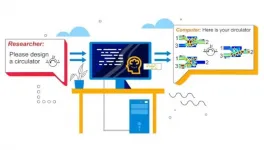INFORMATION:
New atomically precise graphene nanoribbon heterojunction sensor developed
2021-05-12
(Press-News.org) An international research team led by the University of Cologne has succeeded for the first time in connecting several atomically precise nanoribbons made of graphene, a modification of carbon, to form complex structures. The scientists have synthesized and spectroscopically characterized nanoribbon heterojunctions. They then were able to integrate the heterojunctions into an electronic component. In this way, they have created a novel sensor that is highly sensitive to atoms and molecules. The results of their research have been published under the title 'Tunneling current modulation in atomically precise graphene nanoribbon heterojunctions' in Nature Communications. The work was carried out in close cooperation between the Institute for Experimental Physics with the Department of Chemistry at the University of Cologne, as well as with research groups from Montreal, Novosibirsk, Hiroshima, and Berkeley. It was funded by the German Research Foundation (DFG) and the European Research Council (ERC).
The heterojunctions of graphene nanoribbons are just one nanometre - one millionth of a millimetre - wide. Graphene consists of only a single layer of carbon atoms and is considered the thinnest material in the world. In 2010, researchers in Manchester succeeded in making single-atom layers of graphene for the first time, for which they won the Nobel Prize. 'The graphene nanoribbon heterojunctions used to make the sensor are each seven and fourteen carbon atoms wide and about 50 nanometres long. What makes them special is that their edges are free of defects. This is why they are called "atomically precise" nanoribbons,' explained Dr Boris Senkovskiy from the Institute for Experimental Physics. The researchers connected several of these nanoribbon heterojunctions at their short ends, thus creating more complex heterostructures that act as tunnelling barriers.
The heterostructures were investigated using angle-resolved photoemission, optical spectroscopy, and scanning tunnelling microscopy. In the next step, the generated heterostructures were integrated into an electronic device. The electric current flowing through the nanoribbon heterostructure is governed by the quantum mechanical tunnelling effect. This means that under certain conditions, electrons can overcome existing energy barriers in atoms by 'tunnelling', so that a current then flows even though the barrier is greater than the available energy of the electron.
The researchers built a novel sensor for the adsorption of atoms and molecules from the nanoribbon heterostructure. The tunnel current through the heterostructure is particularly sensitive to adsorbates that accumulate on surfaces. That is, the current strength changes when atoms or molecules, such as those of gases, accumulate on the surface of the sensor. 'The prototype sensor we built has excellent properties. Among other things, it is particularly sensitive and can be used to measure even the smallest amounts of adsorbates,' said Professor Dr Alexander Grüneis, head of a research group at the Institute of Experimental Physics.
ELSE PRESS RELEASES FROM THIS DATE:
Ancient gut microbiomes may offer clues to modern diseases
2021-05-12
BOSTON - (May 12, 2021) - Scientists are rapidly gathering evidence that variants of gut microbiomes, the collections of bacteria and other microbes in our digestive systems, may play harmful roles in diabetes and other diseases. Now Joslin Diabetes Center scientists have found dramatic differences between gut microbiomes from ancient North American peoples and modern microbiomes, offering new evidence on how these microbes may evolve with different diets.
The scientists analyzed microbial DNA found in indigenous human paleofeces (desiccated excrement) from unusually dry caves in Utah and northern Mexico with extremely ...
Better integrated circuits with glide symmetry
2021-05-12
Surface plasmon polaritons (SPPs) are highly localized surface waves on the interface between metal and dielectric in the optical frequency band. SSPs do not naturally exist in the microwave and terahertz frequencies, so "spoof" surface plasmon polaritons (SSPPs) are necessary for operations in those lower frequency bands.
Like optical SPPs, microwave SSPPs exhibit highly localized electromagnetic fields, subwavelength resolution, and extraordinary field confinement. Therefore, SSPP transmission lines (TLs) have been proposed as novel types of microwaveguides that offer new solutions for miniaturization, ...
Anesthetic may affect tau spread in the brain to promote Alzheimer's disease pathology
2021-05-12
BOSTON - During the development and progression of Alzheimer's disease, a protein called tau accumulates and spreads in the brain. Understanding the mechanisms behind tau spread--and its consequences--may point to new prevention and treatment strategies for Alzheimer's disease and other forms of dementia. New insights now come from research that was led by investigators at Massachusetts General Hospital (MGH) and involves an anesthetic known to affect cognitive function. The findings are published in Communications Biology.
The scientists note that inflammation plays an important role in Alzheimer's disease, and microglia--immune cells that reside in the brain--are thought to be involved in this process by producing an ...
Untangling the brain: new research offers hope for Alzheimer's disease
2021-05-12
Since the discovery of Alzheimer's disease over a century ago, two hallmarks of the devastating illness have taken center stage.
The first, known as amyloid plaques, are dense accumulations of misfolded amyloid protein, occurring in the spaces between nerve cells. Most efforts to halt the advance of Alzheimer's disease have targeted amyloid protein plaques. To date, all have met dispiriting failure.
The second classic trait has, until recently, received less scrutiny. It consists of string-like formations within the bodies of neurons, produced by another crucial protein-- tau. These are known as neurofibrillary tangles.
In a new study, researchers with the ASU-Banner Neurodegenerative Disease Center at the Biodesign ...
Rapid COVID-19 diagnostic test delivers results within 4 minutes with 90 percent accuracy
2021-05-12
PHILADELPHIA--A low-cost, rapid diagnostic test for COVID-19 developed by Penn Medicine provides COVID-19 results within four minutes with 90 percent accuracy. A paper published this week in Matter details the fast and inexpensive diagnostic test, called RAPID 1.0 (Real-time Accurate Portable Impedimetric Detection prototype 1.0). Compared to existing methods for COVID-19 detection, RAPID is inexpensive and highly scalable, allowing the production of millions of units per week.
Despite the urgency of the pandemic, most available methods for COVID-19 testing use RT-PCR--reverse transcription polymerase chain reaction--to detect ...
On the road to smart cities: Where smart vehicles stand and where they're going
2021-05-12
Central to any technological progress is the enrichment of human life. The internet and wireless connectivity have done that by allowing not only virtually anyone anywhere to connect real time, but by making possible connections between humans and a range of intelligent devices both indoors and outdoors, putting smart cities on the horizon.
One key aspect of realizing smart cities is "smart vehicles", the latest development in intelligent transportation systems (ITS), which involve the integration of communication, mapping, positioning, network, and sensor technologies to ensure cooperative, efficient, intelligent, safe, and economical transportation.
For decades, research on bringing to the streets smart vehicles that operate ...
Computer designs magnonic devices
2021-05-12
The field of magnonics offers a new type of low-power information processing, in which magnons, the quanta of spin waves, carry and process data instead of electrons. The end goal of this field is to create magnonic circuits, which would be smaller and more energy-efficient than current electronic ones.
Until recently, the development of a functional magnonic device could take years of trial-and-error. Researchers from the University of Vienna and the TU Kaiserslautern have developed a new computational method to design new devices in a considerably shorter time. Moreover, the efficiency added through this novel inverse design method helps overcome a traditional problem with such devices: they were just suitable for one function only. Now, thanks to the proposed ...
A hairpin to fight cancer
2021-05-12
The inhibition of pathological protein-protein interactions is a promising approach for treating a large number of diseases, including many forms of cancer. A team of researchers has now developed a bicyclic peptide that binds to beta-catenin--a protein associated with certain types of tumor. The secret of their success is the cyclic nature and the hairpin shape of the peptide, which mimics a natural protein structure, they report in the journal Angewandte Chemie.
Because of the extensive protein regions involved in protein-protein interactions, therapeutic approaches involving small molecules are often unsuccessful. Protein mimetics are alternatives that imitate the spatial structure of binding segments of natural protein binding partners. ...
10 years after obesity surgery: How did life turn out?
2021-05-12
In a new study from Lund University and the University of Gothenburg, patients were interviewed about their experiences ten years after undergoing obesity surgery. The results show that the effect on eating and weight regulation persisted, whereas other problems, such as feelings of guilt about still not being healthy enough, remained.
"This is one of few follow-ups from a patients perspective so long after surgery", says My Engström, researcher in nursing at the University of Gothenburg.
18 patients were interviewed in the study. All of them experienced that their eating habits and appetite were still affected after the operation: their bodies still objected, preventing ...
Researchers develop methods to understand how tb consumes its favourite foods
2021-05-12
Mycobacterium tuberculosis is incredible in that it can survive for decades within its human host. It does this by varying its diet to successfully steal nutrients from the human host including immune cells; it is known to acquire and absorb multiple carbon sources from the body during infection.
In a paper published in the journal Molecular Systems Biology, Surrey scientists detail how they measure the flow of metabolites or "fluxes" through metabolic pathways when Mycobacterium tuberculosis is consuming some of its favourite nutrients. Measuring these 'fluxes' could help scientists advance new tuberculosis drugs as well as understand why the bacterium survives so long in humans and why current antibiotics are often ineffective.
By growing Mycobacterium ...




